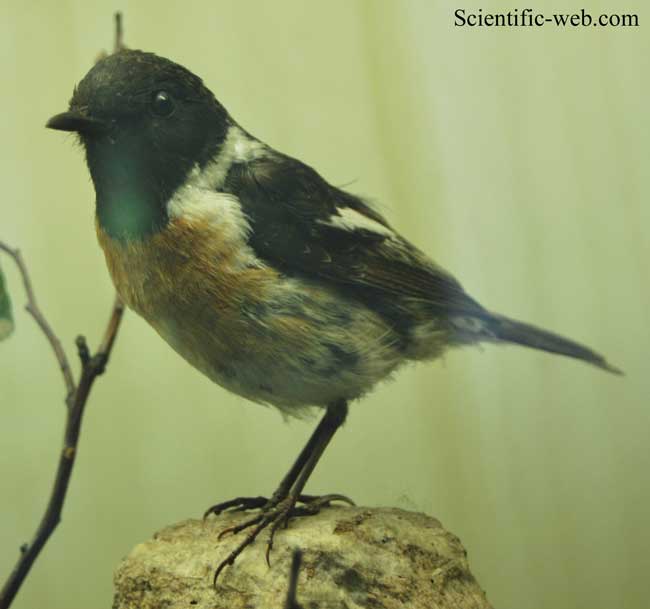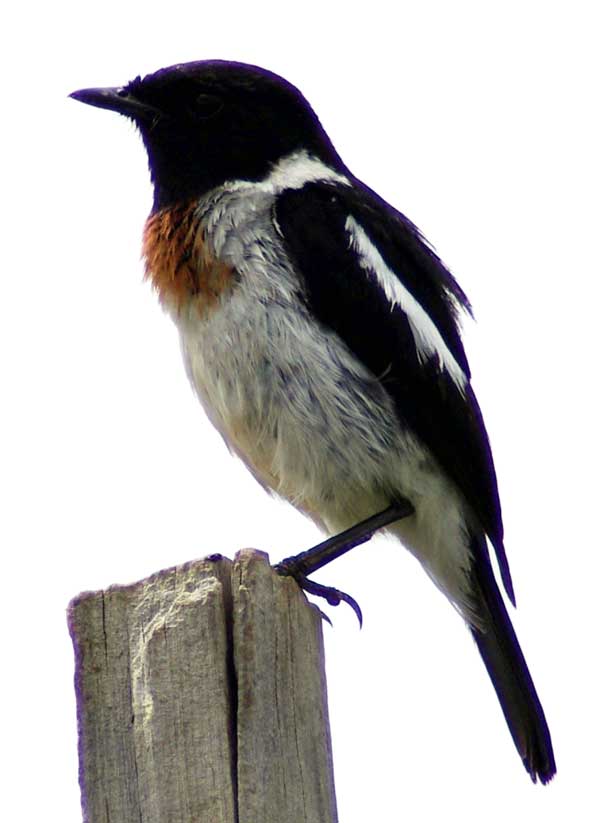
Saxicola torquatus, Photo: Michael Lahanas
Superregnum: Eukaryota
Cladus: Unikonta
Cladus: Opisthokonta
Cladus: Holozoa
Regnum: Animalia
Subregnum: Eumetazoa
Cladus: Bilateria
Cladus: Nephrozoa
Superphylum: Deuterostomia
Phylum: Chordata
Subphylum: Vertebrata
Infraphylum: Gnathostomata
Megaclassis: Osteichthyes
Cladus: Sarcopterygii
Cladus: Rhipidistia
Cladus: Tetrapodomorpha
Cladus: Eotetrapodiformes
Cladus: Elpistostegalia
Superclassis: Tetrapoda
Cladus: Reptiliomorpha
Cladus: Amniota
Classis: Reptilia
Cladus: Eureptilia
Cladus: Romeriida
Subclassis: Diapsida
Cladus: Sauria
Infraclassis: Archosauromorpha
Cladus: Crurotarsi
Divisio: Archosauria
Cladus: Avemetatarsalia
Cladus: Ornithodira
Subtaxon: Dinosauromorpha
Cladus: Dinosauriformes
Cladus: Dracohors
Cladus: Dinosauria
Ordo: Saurischia
Cladus: Eusaurischia
Subordo: Theropoda
Cladus: Neotheropoda
Cladus: Averostra
Cladus: Tetanurae
Cladus: Avetheropoda
Cladus: Coelurosauria
Cladus: Tyrannoraptora
Cladus: Maniraptoromorpha
Cladus: Maniraptoriformes
Cladus: Maniraptora
Cladus: Pennaraptora
Cladus: Paraves
Cladus: Eumaniraptora
Cladus: Avialae
Infraclassis: Aves
Cladus: Euavialae
Cladus: Avebrevicauda
Cladus: Pygostylia
Cladus: Ornithothoraces
Cladus: Ornithuromorpha
Cladus: Carinatae
Parvclassis: Neornithes
Cohors: Neognathae
Cladus: Neoaves
Cladus: Telluraves
Cladus: Australaves
Ordo: Passeriformes
Subordo: Passeri
Infraordo: Passerida
Superfamilia: Muscicapoidea
Familia: Muscicapidae
Genus: Saxicola
Species: Saxicola torquatus
Subspecies: S. t. albofasciatus – S. t. axillaris – S. t. clanceyi – S. t. felix – S. t. jebelmarrae – S. t. moptanus – S. t. nebularum – S. t. oreobates – S. t. promiscuus – S. t. salax – S. t. stonei – S. t. torquatus – S. t. voeltzkowi
Name
Saxicola torquatus (Linnaeus, 1766)
Synonyms
Muscicapa torquata (protonym)
Saxicola torquata (orth. err.)

Saxicola torquatus (*)
References
Systema Naturae ed 12: 328.
Vernacular names
Afrikaans: Gewone Bontrokkie
العربية: البرقش المطوق, القليعي المطوق, بريقش زياني, قليعي مطوق
English: African Stonechat
español: Tarabilla africana
français: Tarier d'Afrique
հայերեն: Չքչքան սևագլուխ
italiano: Saltimpalo africano
日本語: アフリカノビタキ
latviešu: Tumšā čakstīte
Malagasy: Fitadroranga
Nederlands: Afrikaanse Roodborsttapuit
norsk: Afrikasvartstrupe
русский: Черноголовый чекан
Sesotho: Hlatsinyane
Kiswahili: Mhozo Kichwa-cheusi
isiXhosa: Ingcaphe
isiZulu: isAncaphela
The African stonechat or common stonechat[1] (Saxicola torquatus) is a species of the Old World flycatcher family (Muscicapidae), inhabiting sub-Saharan Africa and adjacent regions. Like the other chats, it was long assigned to the thrush family (Turdidae), to which the chats are convergent. Its scientific name refer to its appearance and habitat and means "collared rock-dweller": Saxicola from Latin saxum ("rock") + incola ("one who dwells in a place"), torquatus, Latin for "collared".
In the past S. torquatus usually referred to the entire "common stonechat" superspecies and some sources[4] still keep it that way, but all available evidence strongly supports full species status for the European (S. rubicola) and the Siberian stonechat (S. maurus) of temperate Eurasia, in addition to the island-endemics Fuerteventura chat (S. dacotiae) and Réunion stonechat (S. tectes) which were never unequivocally accepted into S. torquatus. The Madagascar stonechat is also considered distinct. In addition, the well-marked populations of the Horn of Africa uplands may well qualify for an additional species.[5][6][7]
Systematics and taxonomy
In 1760, the French zoologist Mathurin Jacques Brisson included a description of the African Stonechat in his Ornithologie based on a specimen collected from the Cape of Good Hope in South Africa. He used the French name Le gobe-mouche à collier du Cap de Bonne Espérance and the Latin Muscicapa Torquata Capitis Bonae Spei.[8] Although Brisson coined Latin names, these do not conform to the binomial system and are not recognised by the International Commission on Zoological Nomenclature.[9] When in 1766 the Swedish naturalist Carl Linnaeus updated his Systema Naturae for the twelfth edition, he added 240 species that had been previously described by Brisson.[9] One of these was the African Stonechat. Linnaeus included a brief description, coined the binomial name Muscicapa torquata and cited Brisson's work.[10] The specific name is from Latin torquatus "collared".[11] This species is now placed in the genus Saxicola that was introduced by the German naturalist Johann Matthäus Bechstein in 1802.[12]
The closest relative of this species are apparently not the Eurasian populations but the Réunion stonechat (S. tectes), but still the "white-collared" Saxicola form a distinct group in the genus. S. torquatus and S. tectes form a sub-Saharan African lineage that diverged from the Eurasian one in the Late Pliocene, roughly 2.5 million years ago. Réunion was colonized shortly thereafter, indicating a rapid expansion along the Indian Ocean coast of Africa. With the Sahara drying out in the subsequent Quaternary glaciation, the African and Eurasian populations became isolated for good.[7]
The recent separation as species was proposed after mtDNA cytochrome b sequence and nDNA microsatellite fingerprinting analysis of specimens of the subspecies Saxicola torquatus axillaris but not S. t. torquatus, and hence this species was briefly known as S. axillaris.[7]
Subspecies
There are 13 recognised subspecies.[13] They differ slightly in size, and more in the extent of the orange-red on the upper breast of the males, and whether the lower breast is white with a distinct boundary from the upper breast, or pale orange with an indistinct boundary from the darker upper breast. The extent of the orange-red also varies with time of year, often extending on to the belly outside the breeding season.[14]
S. t. felix Bates, 1936 – southwest Saudi Arabia and west Yemen
S. t. albofasciatus Rüppell, 1840 – southeast Sudan and northeast Uganda to central Ethiopia
upper breast black, not orange-red[15]
S. t. jebelmarrae Lynes, 1920 – east Chad and west Sudan
S. t. moptanus Bates, 1932 – Senegal and south Mali
The smallest subspecies.
S. t. nebularum Bates, 1930 – Tropical West Africa from Sierra Leone to west Ivory Coast
Extensive orange-red on breast and also flanks.
S. t. axillaris (Shelley, 1885) – east Democratic Republic of the Congo, Kenya, north and west Tanzania
S. t. promiscuus Hartert, 1922 – south Tanzania to east Zimbabwe and west Mozambique
Very limited orange-red on uppermost part of breast only.
S. t. salax (Verreaux, J & Verreaux, E, 1851) – east Nigeria to northwest Angola, Bioko Island
S. t. stonei Bowen, 1931 – east and south Angola to southwest Tanzania south to north South Africa and Botswana
S. t. clanceyi Courtenay-Latimer, 1961 – coastal west South Africa
S. t. torquatus (Linnaeus, 1766) – central South Africa
S. t. oreobates Clancey, 1956 – Lesotho
S. t. voeltzkowi Grote, 1926 – Grande Comore
Description
The males have a black head, a white half-collar, a black back, a white rump, and a black tail; the wings are black with a large white patch on the top side of the inner wing. The upper breast is usually dark orange-red, with a sharp or gradual transition to white or pale orange on the lower breast and belly depending on subspecies. In a few, black replaces the orange breast feathers in part or entirely.[14]
Females have brown rather than black above and on the head with an indistinct paler eyebrow line, chestnut-buff rather than orange below, and less white on the wings. Both sexes' plumage is somewhat duller and streakier outside the breeding season.[14]
Distribution and habitat
It has a scattered distribution across much of sub-Saharan Africa, occurring locally as far north as Senegal and Ethiopia. Outlying populations are found the mountains of southwest Arabia and on Madagascar and Grande Comore. It is non-migratory, moving only locally if at all. As a result, it has developed much regional variation, being divided into 13 subspecies.[14]
References
BirdLife International (2020). "Saxicola torquatus". IUCN Red List of Threatened Species. 2020: e.T22710184A181614254. doi:10.2305/IUCN.UK.2020-3.RLTS.T22710184A181614254.en. Retrieved 6 March 2022.
Friedmann, Herbert (1937). Birds Collected by the Childs Frick Expedition to Ethiopia and Kenya Colony, Bulletin 153, Part 2. Washington, DC: Smithsonian Institution, United States National Museum. p. 146. ISBN 9780598369482.
Steve., Sax (1986). Sax!. Contemporary Books. ISBN 0-8092-5062-4. OCLC 13333745.
E.g. BLI (2008)
Wittmann et al. (1995), Urquhart & Bowley (2002)
Woog, F.; Wink, M.; Rastegar-Pouyani, E.; Gonzalez, J.; Helm, B. (2008). "Distinct taxonomic position of the Madagascar stonechat (Saxicola torquatus sibilla) revealed by nucleotide sequences of mitochondrial DNA". Journal of Ornithology. 149 (3): 423–430. doi:10.1007/s10336-008-0290-1.
Wink, M.; Sauer-Gürth, H.; Gwinner, E. (2002). "Evolutionary relationships of stonechats and related species inferred from mitochondrial-DNA sequences and genomic fingerprinting" (PDF). British Birds. 95: 349–355.
Brisson, Mathurin Jacques (1760). Ornithologie, ou, Méthode contenant la division des oiseaux en ordres, sections, genres, especes & leurs variétés (in French and Latin). Vol. 3. Paris: Jean-Baptiste Bauche. pp. 379–380, Plate 36 fig 4. The two stars (**) at the start of the section indicates that Brisson based his description on the examination of a specimen.
Allen, J.A. (1910). "Collation of Brisson's genera of birds with those of Linnaeus". Bulletin of the American Museum of Natural History. 28: 317–335. hdl:2246/678.
Linnaeus, Carl (1766). Systema naturae : per regna tria natura, secundum classes, ordines, genera, species, cum characteribus, differentiis, synonymis, locis (in Latin). Vol. 1, Part 1 (12th ed.). Holmiae (Stockholm): Laurentii Salvii. p. 328.
Jobling, J.A. (2018). del Hoyo, J.; Elliott, A.; Sargatal, J.; Christie, D.A.; de Juana, E. (eds.). "Key to Scientific Names in Ornithology". Handbook of the Birds of the World Alive. Lynx Edicions. Retrieved 10 May 2018.
Bechstein, Johann Matthäus (1802). Ornithologisches Taschenbuch von und für Deutschland, oder, Kurze Beschreibung aller Vögel Deutschlands für Liebhaber dieses Theils der Naturgeschichte (in German). Leipzig: Carl Friedrich Enoch Richter. p. 216.
Gill, Frank; Donsker, David, eds. (2018). "Chats, Old World flycatchers". World Bird List Version 8.1. International Ornithologists' Union. Retrieved 10 May 2018.
Urquhart & Bowley (2002)
Clement & Rose 2015, pp. 122–123, 484.
Sources
Boulton, Rudyerd & Rand, A.L. (1952). A collection of birds from Mount Cameroon. Fieldiana Zool. 34(5):35-64. Fulltext at the Internet Archive
Clement, Peter; Rose, Chris (2015). Robins and Chats. Helm Identification Guides. London: Bloomsbury. ISBN 978-0-7136-3963-6.
Urquhart, Ewan & Bowley, Adam (2002). Stonechats. A Guide to the Genus Saxicola. Christopher Helm, London. ISBN 0-7136-6024-4
Wittmann, U.; Heidrich, P.; Wink, M. & Gwinner, E. (1995). Speciation in the Stonechat (Saxicola torquata) inferred from nucleotide sequences of the cytochrome b-gene. Journal of Zoological Systematics and Evolutionary Research 33(2):116-122. doi:10.1111/j.1439-0469.1995.tb00218.x HTML abstract
Retrieved from "http://en.wikipedia.org/"
All text is available under the terms of the GNU Free Documentation License

